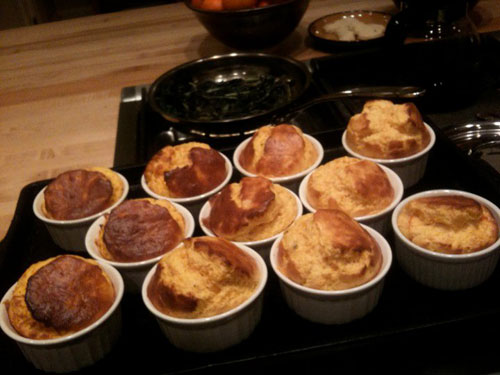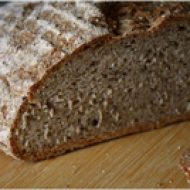Not Chef Boyardee
There was a time in my life, preparing for qualifying exams in graduate school, when I ate nothing but cold Chef Boyardee canned ravioli straight out of the can for about a month. I am so happy that those days are behind me now, and in middle age I can take an hour to make homemade ravioli for my family for dinner. These ravioli taste a lot better than Chef Boyardee, and they’re much healthier too!
How to make homemade ravioli:
First make the pasta:
In a medium-size mixing bowl, mix 3 cups of flour, 6 eggs, 1/3 cup of olive oil, and a pinch of kosher salt. Add water if needed. Mix with a wooden spoon until the dough forms a ball and pulls away from the walls of the bowl.
Turn out the dough on to a floured surface and knead for two or three minutes, until the dough is smooth and stretchy. Divide the dough into two halves and set aside, covered by a dishtowel.
Now make the filling:
You can put pretty much anything in your ravioli filling, from chopped lamb to mashed peas. I often do mushrooms and spinach, or shrimp and spinach. For shrimp and spinach, just take frozen precooked shrimp out of the freezer – no need to defrost them – and pick the leaves off a bunch of spinach (compost the stems).
For mushrooms and spinach, set a medium-sized frying pan on medium heat, and put in two tablespoons of olive oil. Slice up four mushrooms and saute the mushrooms in the olive oil until they soften. Meanwhile, pick the leaves off your spinach as above.
At this point, put a large casserole of water on to boil over high heat. Use a rolling pin to roll out one of the balls of dough until it is at least as big as a cookie sheet. The dough should be about as thin as you can get it without tearing it. When it seems hard to get it any thinner, pick it up and turn it over, and try again. You’ll need to turn it over three or four times.
Put a few leaves of spinach down where you want the centers of your ravioli to be, dotted all over your pasta. On top of the spinach, put either shrimp or mushrooms (or both!). Now, on a different part of the counter, roll out the other half of the dough about the same size. Brush water on the bottom layer between all of the dabs of filling, and gently lay your top sheet over the top of the ravioli.
Press down between the dots of filling so you can see where the fillings are. The water will help seal the raviolis. If you have a ravioli cutter, roll it between the ravioli to cut them apart and seal them at the same time. Otherwise, use a knife or a pizza wheel to cut the raviolis apart, and then use your fingers to pinch the raviolis closed around the edges (this is the tedious part).
By this time your water will probably be boiling, so gently drop the raviolis into the boiling water. Stir them gently with a wooden spoon, and let them boil for about five minutes. Lift them out of the water with a slotted spoon, or pour them into a colander to drain, and run cold water over them briefly to get the starch off so they don’t stick together. If some of the ravioli come apart, that’s okay.
Serve the ravioli plain with a little olive oil splashed over them for a sauce, or serve in tomato sauce, or in pesto sauce. We usually have ravioli just with a salad because by the time I’m done making ravioli I don’t have the energy for real side dishes. But you could also get fancier and serve ravioli with sauteed pea pods or grated carrots.
Vegetarian or vegan?
Ravioli’s vegan as long as you only use vegan stuff for the filling and the sauce. It makes a good vegan main dish.
Will ravioli keep?
You can certainly keep leftover ravioli in a sealed tupperware in the refrigerator for a couple of days, and reheat it for lunch in the microwave. It’s not as good as it is fresh, though.

